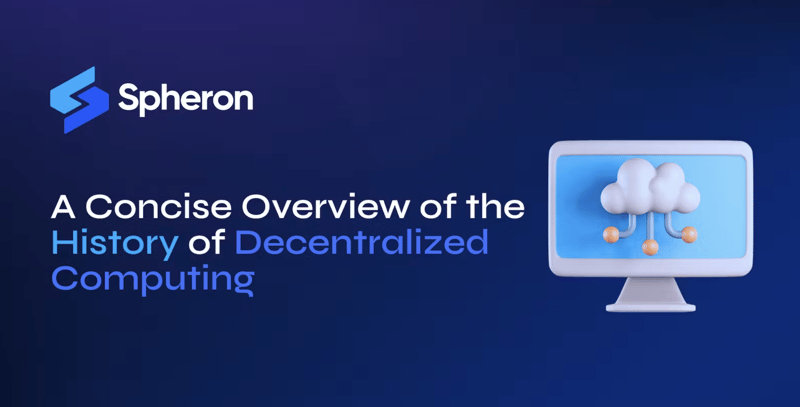Decentralization in computing can be interpreted in various ways, depending on the context. In the cryptocurrency industry, "decentralized" may refer to the decentralization of access, organizational governance, computation, financial instruments, and wealth. Here, we'll focus on decentralization in terms of computing resources and accessibility, with an emphasis on user rights, privacy, and security.
To comprehend decentralized computing, it's essential to understand centralized computing first. Centralized computing occurs when crucial application services are managed by interacting with a remote central location. In this setup, users from different locations connect to the same service or address to utilize computing resources like data storage and processing.
Now, let's define decentralized computing based on the earlier explanation:
Decentralized computing occurs when individual computing devices or nodes perform essential application services within a distributed network without a central location. In a decentralized architecture, there is no single service address that, if disabled, would disrupt core application functionality for all users. If you cannot pinpoint a central address to shut down and affect all users, you are likely dealing with a decentralized computing system.
From Centralized Behemoths to Decentralized Dynamos
In the era preceding the 1950s, the groundwork for the computing age was laid through advancements in mathematics, logic, and computational theory. From 1940 to 1980, computing was primarily the domain of large organizations boasting multi-million dollar budgets. Centralization was a defining characteristic during this period, with mainframe computers dominating the market. These early computers, often the size of rooms or small buildings, allowed only one user to access the system at a time, resulting in a highly centralized approach to computation and resource access.
The shift towards decentralization began with the introduction of time-sharing and multi-user operating systems like Unix, developed at Bell Labs in 1969. The 1960s witnessed the emergence of the first time-sharing systems, offering a groundbreaking advantageusers could collaborate on shared files and engage in real-time communication through features like instant messaging (embedded in Unix with the 'talk' command) and email (initially limited to users on the same shared computer around 1970).
It began with the conception of a decentralized computer system known as Mix Network by David Chaum in 1979. This system provided an anonymous email communication network, which decentralized the authentication of messages in a protocol that would become the precursor to Onion Routing, the protocol of the TOR browser. A significant driving force behind the development of multitasking features, which have become standard in operating systems, was the constraint of early computers, allowing only one user to access the system for computations at a time. Multitasking operating systems like Unix revolutionized this limitation by enabling multiple users to simultaneously sign in and use the same computer. The system efficiently switched between different user applications, aiming to provide a seamless experience, though heavy usage could sometimes lead to noticeable delays.
From Room-Sized Behemoths to Pocket-Sized Powerhouses: The Evolution of Decentralized Computing
Between 1960 and 1970, computers radically transformed from room-sized structures to compact desk-fitting devices. This marked the precursor to the personal computing revolution that was about to unfold, as the decentralization of access to computing resources took its initial steps with multitasking operating systems and the advent of dumb terminalskeyboard and monitor setups without their CPUs and memory, connected to a shared central computer.
In the 1970s, the personal computing revolution began, and by 1980, personal computing had entered the public consciousness. Each user has their computer, their memory, and their CPU. Although most home computers were not connected to each other and could only communicate by sharing physical memory devices such as tapes, cartridges, and floppy disks, this marked the beginning of decentralization.
Building a Better Web: The Promise of Decentralized Technologies
The internet has come a long way since its creation in 1990 by Tim Berners-Lee. At first, only a small percentage of people had access to the Internet, but by 2000, 52% of US households owned a computer, and 46% were online. By 2010, 80% of American households had internet access.
In the early days of the internet, software was king, but now the web is the world's largest decentralized application. Anyone can create a website and share information with anyone else. However, the content on the web is still centralized, meaning that a single entity controls it.
Around 2000, decentralized protocols like email and Usenet led to the development of distributed computing projects like SETI@Home and Folding@Home. These projects allowed people to work together to achieve a common goal without a central authority controlling everything. Peer-to-peer applications like Napster, BitTorrent, and Tor also emerged, allowing people to share files and data directly.
The Human Genome Project, which mapped the entire human genome, was completed in 13 years thanks to collaboration and shared resources among 20 institutions. This shows the potential of decentralized applications to change the world. Napster revolutionized the music industry by allowing people to share music files directly with each other, bypassing traditional record labels. This demonstrates the power of decentralized applications to disrupt established industries.
Over time, the web evolved from a platform for decentralized publishing to a platform for building applications. Modern web browsers offer many features like networking, user interface, device access, and more. While other platforms can match the web's technical abilities, it remains the most widespread application platform ever made, making it an ideal base for decentralized computing.
However, there's a catch - the web is based on a client-server architecture, where a central server provides client services. There aren't any decentralized service nodes built into web browsers, and we haven't decided what these services should look like yet. As a result, application developers have returned to centralized solutions.
Centralization Conundrum: Who Owns Your Online Content?
Between 2004 and 2010, social media platforms gained widespread popularity, leading to users spending significant amounts of time on apps like Instagram, Facebook, Twitter, TikTok, YouTube, and Medium. However, this resulted in a concentration of user-generated content within a few applications, raising concerns about data ownership and control.
The current scenario poses challenges for users who may want to transition away from these platforms while retaining their accumulated content and connections. Users risk losing their social network, posts, photos, and videos if a platform shuts down. This potential loss can be distressing and have a profound impact on users.
Moreover, the centralized storage of sensitive, personal data on these platforms raises concerns about privacy and security. Users may be vulnerable to various risks if this data falls into the wrong hands.
Although cloud computing resources have facilitated the creation of applications with extensive user reach, the drawback is that user data remains locked within centralized platforms beyond the users' control. The challenge lies in finding ways to enable data sharing between applications while placing control back in the hands of the users to safeguard their rightful ownership of the data.
The Rise of Decentralized Applications
Imagine a world where managing your user profile across various applications is a breeze. Picture seamlessly sharing your profile or switching between different personas with just a click. No more creating another username and password for each new site you connect to. Forget the constant worry about password theft or data breaches.
Exciting new services like 3Box and Tim Berners-Lee's Solid are working towards making this vision a reality. Yes, the same Tim Berners-Lee who invented the web aims to revolutionize it by building on decentralized architecture for user data.
As developers, we must prioritize the privacy and security of our users. Users should have ownership and control over their data, which should be encrypted and safeguarded against unauthorized access by default.
Picture a world where users can easily grant and revoke application access to their data whenever they want. Envision users having full control over who gets access to their social connections. Imagine users being the masters of their own posts, photos, videos, and data. That's the promise of modern decentralized applications putting the power back into the hands of users.
Where can DApps be used?
DApps (Decentralized Applications) can be used in various industries and sectors, including:
Financial Services: DApps can facilitate peer-to-peer financial transactions, such as exchanging currencies or transferring assets. They can also enable secure, efficient cross-border payments and decentralized lending.
Supply Chain Management: DApps can track the movement of goods through a supply chain, ensuring transparency and accountability.
Identity Verification: DApps can securely store and verify identity information, such as for voter rolls or passport applications.
Real Estate: DApps can facilitate the buying and selling of real estate directly between buyer and seller, as well as the tracking of property ownership and related documentation such as deeds.
Healthcare: DApps can store and track healthcare records, as well as facilitate the communication and collaboration of healthcare professionals.
Education: DApps can create decentralized learning platforms, allowing students and teachers to interact and collaborate without intermediaries.
Social Media: DApps can create decentralized social media platforms, allowing users to interact and share content without a central authority.
Predictive Markets: DApps can create decentralized platforms for predictive markets, allowing users to make predictions on various topics and potentially earn rewards for accurate predictions.
Voting Systems: DApps can create secure and transparent voting systems resistant to fraud and censorship.
Gaming: Blockchain-based games let players trade in-game assets as non-fungible tokens secured on the blockchain, providing verifiable ownership and scarcity.
Music: DApp services, such as Audius, reward users with social tokens for uploading original music, interacting with other musicians, and sharing songs online.
Energy Trading: DApps can create peer-to-peer energy trading platforms, allowing households and businesses to buy and sell excess energy directly.
Real Estate: DApps can create decentralized property ownership and rental management systems, reducing the need for intermediaries and increasing transparency.
Conclusion
In conclusion, decentralized computing is a rapidly evolving field with great promise for transforming various industries and sectors. By empowering users with control over their data and fostering transparency, security, and efficiency, decentralized applications (dApps) are poised to revolutionize how we interact and conduct business. From finance and supply chain management to healthcare, education, social media, and gaming, the potential use cases for dApps are vast and diverse.
As the world becomes increasingly digital, it is essential to ensure that technology serves the needs of individuals and society rather than concentrating power in the hands of a select few. Decentralized computing offers a powerful toolkit for achieving this goal, enabling the creation of open, inclusive systems that promote collaboration, innovation, and user autonomy.
While there are challenges to overcome in developing and implementing dApps, the benefits of decentralization are undeniable. As the next generation of technologists, entrepreneurs, and thought leaders, we must harness the power of decentralized computing to build a better future for all.







Top comments (0)